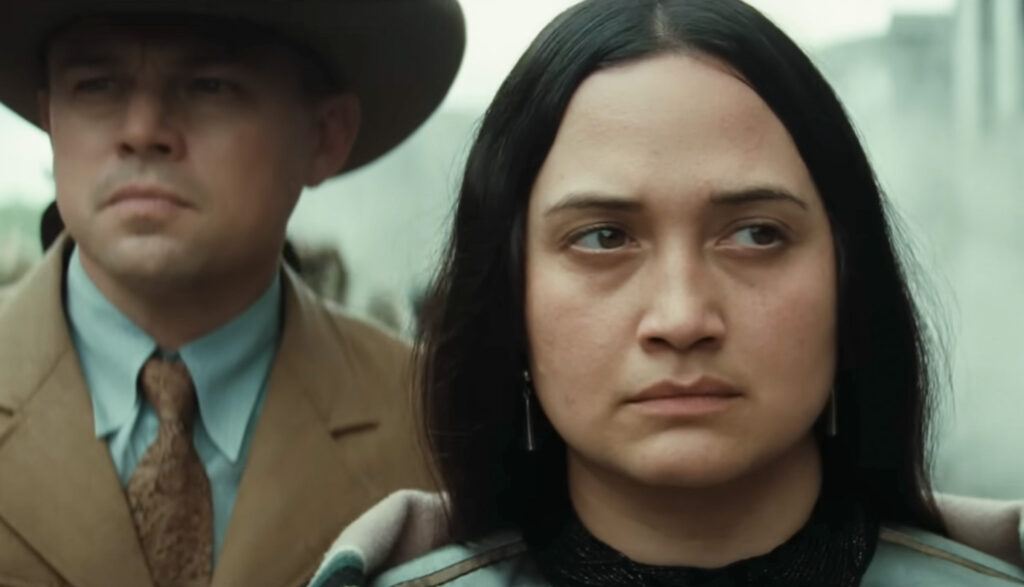
Oklahoma’s earth is dark, rich. Corn, cotton and wheat all grow well here. Lush native grasses offer livestock plenty of grazing.
And the wildflowers! The people of the Osage Nation marveled at their springtime beauty, blooming during what they called the Flower Moon.
But in the 1920s, nothing in Oklahoma grew as thick, as easily, as greed.
The oil under the earth is dark, rich. Those new automobiles thirst for it. And people do, too. But in this northern corner of Oklahoma, that dirty, dark liquid belongs to the Osage—a people pushed to this territory when no one else wanted it. They bought their reservation outright from the government in 1872—a rarity, to be sure. As such, they kept the land’s mineral rights.
Two decades later, oil gurgled up through the dirt. And just like that, the Osage people became the richest people, per capita, on the planet.
But just as pollen draws bees, wealth draws thieves, charlatans and worse.
Ernest Burkhart arrives in Fairfax, Oklahoma, shortly after World War I. He needs a job. And his uncle, William “King” Hale, says he might have one. Admittedly, Ernest can’t do much: His gut keeps Ernest from heavy labor, and the guy’s not exactly the sharpest knife in the drawer. But he can drive a car. Yes, that he can do.
And do he does. He serves as a cabbie to the Osage—taking them to and from town, waiting while they do their shopping. But he especially loves driving a woman named Mollie around. Quiet Mollie. Pretty Mollie. Rich Mollie.
That suits King Hale fine, just fine. In fact, he’d like Ernest to get closer yet. Why, he’d love to see them get married, he would. Love is such a beautiful thing. And he thinks the world of Mollie.
‘Course, it doesn’t hurt in King’s calculus that Mollie’s whole family, her mother and three sisters, are filthy rich in oil. One of those sisters has been feeling a bit poorly lately. She might not be long for this world. Mollie’s mother, Lizzie Q, is old and frail. Soon, Mollie’s family might be smaller—and their share of the fortune larger.
And let’s be honest, strange things have been happening around Fairfax. The Osage keep dying young. No one knows why—or, at least, so they say. Could be that Mollie’s sisters might die, too? One’s been known to drink heavily. She carries a gun, too. She’s a ticking time bomb, that one. And the other? Well, you know what they say: Accidents happen.
And Mollie? She suffers from diabetes. And women don’t live long in these parts with diabetes.
And then, when—er, if—all sisters should tragically pass on, that whole fortune might fall right in Ernest’s lap. And that lap is just one step removed from King’s own coffers.
That suits King Hale fine. Just fine.
Killers of the Flower Moon is based on a true and tragic chapter in American history. It involved the murders and unexplained deaths of dozens, perhaps hundreds, of Osage Native Americans in the 1920s. Accordingly, moviegoers meet plenty of nasty, duplicitous characters here. But Osage County has its share of good folks, too.
One of them is, most certainly, Mollie. She clearly loves her family and serves as a dutiful (if somewhat overlooked) daughter to her mother, Lizzie Q. She cares for Lizzie in her last sickness and does what she can to help her other sisters, too. And when she marries Ernest, she seems to be a good, fair, mother to their kids.
But she’s as concerned about these unexplained deaths as anyone, and she’s determined to put them to a stop. She, along with other Osage, sends a representative to Washington, D.C., to find official governmental help. She hires a private investigator. And when both of those people mysteriously disappear, she goes to Washington herself—despite being debilitatingly ill.
We see other people, both Osage and white, attempt to solve these murders or to stand up to the suspected perpetrators. And eventually, help does come down from Washington: Tom White, who introduces himself as an agent for the newly formed Federal Bureau of Investigation.
At first, White comes across as a deferential, ineffective investigator—all too willing to back down and come back at a time more convenient for his prime suspects. But as the film goes on, White’s strategy becomes more clear: He acts as public face of the investigation while the real detecting is done by undercover operators.
The spiritual atmosphere in Killers of the Flower Moon comes in layers.
We see a lot of Osage ceremonies. Marriages, burials, christenings and celebrations all come with an indigenous twang. A pipe is buried in a sad ceremony, representing the passing of the Osage way of life. Apples are left on the lids of coffins, and little children sometimes are made to walk across them. Osage leaders, and others, occasionally reference “Wah-Kon-Tah,” the Osage creator spirit.
But many Osage who participate in these ceremonies also consider themselves Christian. Leaders who invoked Wah-Kon-Tah openly talk about the Lord and heaven as well, suggesting that the Osage consider the two to be one and the same. Funerals and christenings, while incorporating some specifically Osage rituals, appear to be largely rooted in the Christian faith (with priests presiding over the ceremony). And the movie suggests that at least during this period of time, Osage traditional beliefs have blended with Christian faith.
The real Mollie Burkhart was said to have been a devout Catholic, and her faith is reflected in the movie. When Ernest tells her that he’s a Christian, she notes that she’s not seen him in church. When he attends with her, she snickers a bit when he stands as everyone else bends to kneel. And as the story grows darker, Mollie chooses to confess one of her most deeply held fears and suspicions to her Catholic priest. But when Ernest joins her for dinner one night and a huge storm rages through, Mollie demands that the two of them remain quiet during the storm—a deluge that she believes carries special power.
King Hale certainly wants people to think he’s a devoted Christian. He tells Ernest that the Osage are the best people on “God’s green Earth.” He references Bible verses and stories frequently, and he sometimes breaks into spontaneous prayer. But he’s been known to invoke Wah-Kon-Tah as well—largely to show his solidarity with and support of the Osage people.
Osage women see visions of owls, which they interpret as ill omens for themselves and for their people. We hear about dreams and what they might mean—including one where Mollie worries about a relative not being able to go into the afterlife because her body didn’t have a face. A woman—dying or dead—crosses over into the afterlife, guided by ancestors and/or loved ones.
When Ernest first arrives, King quizzes him about his sexual experiences and inclinations. He asks him whether he came back from World War I with any “diseases” (his meaning crudely obvious through context) and whether he likes women. When Ernest says he does, King asks, “red women?” Ernest says he likes women of all colors (including blue) and of all shapes and sizes. “I’m greedy,” he adds.
Soon (with a bit of encouragement from King), Ernest develops a special attraction to Mollie. The two grow closer, both romantically and physically. They make out furiously in a truck (with Ernest’s hand wedged against Mollie’s chest through her garments) when Ernest asks Mollie to marry him. We see the couple making out elsewhere—sometimes revealing a bit of skin but nothing critical. When Mollie pulls Ernest on top of her in bed, Ernest jokes that Mollie’s trying to wake the children.
Anna, Mollie’s provocative sister, believes that she’s the girlfriend of Bryan Burkhart, Ernest’s older brother (and a close King confidante). In a public setting, Bryan accuses her of being with other men and shrugs off the idea they were involved at all. (Anna crudely insists otherwise.) When Bryan then makes some lewd moves on a nearby maid—including coming close and holding her around the middle—Anna grows angry and threatens to kill them both.
[Spoiler Warning] When Anna is found dead later, doctors discover that she was pregnant, and King suggests that it might be his child.
A scene takes place in what seems to be a saloon and brothel, with a man clutching the exposed thigh of a woman at a table.
A woman is found dead—the body having been left to the elements for several days. We don’t see much of the corpse, but we do hear as doctors saw open the victim’s skull, then stick something into the brain to, apparently, find the bullet lodged there. We later see the actual murder from a distance—done via revolver close to the head. We’re told that the body was later exhumed, perhaps flayed and finally cut into bits.
An explosion rips through a family home. One woman is found lying dead; when would-be rescuers lift the body, the back of her skull flaps open. A survivor of the blast screams for someone to shoot him. (We only see part of him, bloodied and trapped under debris.) Someone at the site steps on the part of a disembodied hand. He’s told that it likely belongs to the maid; parts of her body have been retrieved all evening.
We see other, less gruesome murders and killings. Someone is instructed to make one murder look like a suicide; but that plan is foiled when the victim is shot in the back of the head, and the killer takes the gun with him. A young mother is shot on a well-manicured front lawn, shortly after putting a baby in a buggy. The killer then spirits the baby back inside as the woman’s body is left to bleed on the lawn. (Coroners later determined the death to be a suicide.)
Would-be robbers are thwarted by a store owner, who shoots the first man to break in with a shotgun. (We see the bloodied body.) Another man, his head already bleeding, drives his car into a tree. (A friend of his tells authorities that an “angel” took him.)
Someone else gets gunned down. A body is found in a pool of muddy water or oil. A man drinks poisoned liquor, apparently, and jerks on the floor as he dies, foaming at the mouth. Several people die from mysterious diseases, and we see their bodies prepped for burial. Two people are beaten to death. (We see parts of the attacks and the bodies thereafter.)
People contract other people to kill. Threats are made. A young girl dies from disease, and we see her dead body. People fight at a train station. Part of a ranch burns. Someone threatens self-harm, and we hear that this individual tried to commit suicide earlier.
One or two uses of the f-word and about a half-dozen s-words. We also hear “a–,” “b–ch,” “b–tard,” “d–n” and “h—.” God’s name is abused about a dozen times, the majority of those misuses with the word “d–n.”
While the movie takes place during Prohibition, alcohol still flows freely in this corner of the United States. Anna, Mollie’s sister, has a drinking problem. (And the film suggests that her habit was encouraged by King.) We see her often tipsy or drunk. When Mollie reprimands her for already being snockered one morning, Anna brags that she’s never been to bed.
Another Osage, Henry, has his own dependence on alcohol encouraged. Prone to despondency, he demands that someone either give him booze or give him a gun (so he, presumably, can take his own life). In the end, a man introduces Henry to a particularly potent form of moonshine. The two drink together frequently before their relationship is, shall we say, terminated.
We see where that moonshine is made, and are introduced to those who make it. Later, that alcohol still is found completely torn apart.
Over dinner during their short courtship, Mollie asks Ernest whether he likes whiskey. He sorely does, Ernest says, and she promises him that the whiskey she has is top-shelf stuff. The two drink it then and elsewhere. King and Ernest also drink together.
Mollie, Ernest and others smoke cigarettes. King smokes the occasional cigar.
[Spoiler Warning] Mollie receives what are called insulin injections, but they only seem to make her sicker. As her search for the Osage killers continues, Ernest is asked to mix another substance into the insulin, which (he’s told) will just “calm her down.” Ernest, either suspicious or curious, dumps some of the substance into his own whiskey and drinks it down.
Toward the end of Mollie’s sickness, she often clutches a pot in bed, apparently to vomit into.
While the Osage may be rich, they’re subjected to a great deal of prejudice and bigotry—and in a number of different shades. Some folks are semi-openly hostile to the Native Americans, robbing them while wearing sacks of their heads and hurling derogatory slurs in their direction.
But a lot of the abuse is more veiled. Some people seem to think that the Osages’ wealth is an aberration, and that the oil will inevitably make its way into the hands of white Americans, whom they believe are the more deserving race. Certainly, the white power structure around Osage county turns a disturbingly blind eye to the murders and injustices committed there, and the federal government also seems slow to respond.
As far as enumerating all the many underhanded tricks and schemes in play … well, we’d likely run out of room.
People rob graves and gamble with the stolen loot. A Ku Klux Klan troop marches openly through Fairfax’s main street.
Killers of the Flower Moon is, as mentioned, based on a 2017 non-fiction book by journalist David Grann, which unpacked a grim chapter of American history—the wrongs of which were only partly addressed. At least 60 Osage Native Americans were killed between 1918 and 1931 in Osage County, with other suspicious deaths perhaps ballooning that total into the hundreds. Many of the murders were never solved.
Those tragic, complex underpinnings make for a rather grim movie. We’re subjected to so many jarring deaths and, sometimes, wince-worthy gore. Stretching over three-and-a-half hours, Killers of the Flower Moon can be a hard film to take in. It’s not really slow, and it’s never really boring. But it can feel like an Oklahoma storm, loud and terrible, where we’re trapped inside.
And yet, Killers of the Flower Moon also showcases director Martin Scorsese’s late-career movie mastery—and illustrates some perhaps unexpected restraint.
Scorsese’s films, from Taxi Driver to Goodfellas to The Wolf of Wall Street, are among cinema’s most lauded works—but they’re among the most problematic, too. Scorsese’s storytelling is invariably riveting but often outrageously bloody, foul and, in the case of Wolf, flat-out gratuitous.
And yet for Scorsese, even that gratuity comes with a message. In that case, the director insists that all that extreme content was necessary to tell what he considered to be a cautionary tale.
In Killers of the Flower Moon, Scorsese gives us another cautionary tale, but without the gratuity. Yes, he’s aided by the movie’s time setting, when the f-word wasn’t hurled like pebbles on a playground. Yes, the movie is still rated R, and with reason. Killers mangle bodies and snuff out lives with barely a backward glance.
But those moments of grotesquery remind us of the dehumanizing racism at play here: These aren’t murders, the killers seem to think. Just messy jobs. Even as King Hale praises the Osage people as being the “best on God’s green Earth,” he schemes and plots and, without lifting a finger, kills to pad his own portfolio. God and the good ol’ boys form convenient cover for the worst of crimes.
On the other side, we’re given the quiet, determined dignity of Mollie Burkhart—a woman of deeper faith and stronger conviction. And in the middle wavers her husband, Ernest.
In a telling scene, Ernest cackles about how much he loves money—loves it almost as much as his wife. And therein lies the moral struggle of Killers of the Flower Moon: the pull and power of greed that can tear you away from what you truly should love, what you truly should value.


Paul Asay has been part of the Plugged In staff since 2007, watching and reviewing roughly 15 quintillion movies and television shows. He’s written for a number of other publications, too, including Time, The Washington Post and Christianity Today. The author of several books, Paul loves to find spirituality in unexpected places, including popular entertainment, and he loves all things superhero. His vices include James Bond films, Mountain Dew and terrible B-grade movies. He’s married, has two children and a neurotic dog, runs marathons on occasion and hopes to someday own his own tuxedo. Feel free to follow him on Twitter @AsayPaul.
Our weekly newsletter will keep you in the loop on the biggest things happening in entertainment and technology. Sign up today, and we’ll send you a chapter from the new Plugged In book, Becoming a Screen-Savvy Family, that focuses on how to implement a “screentime reset” in your family!